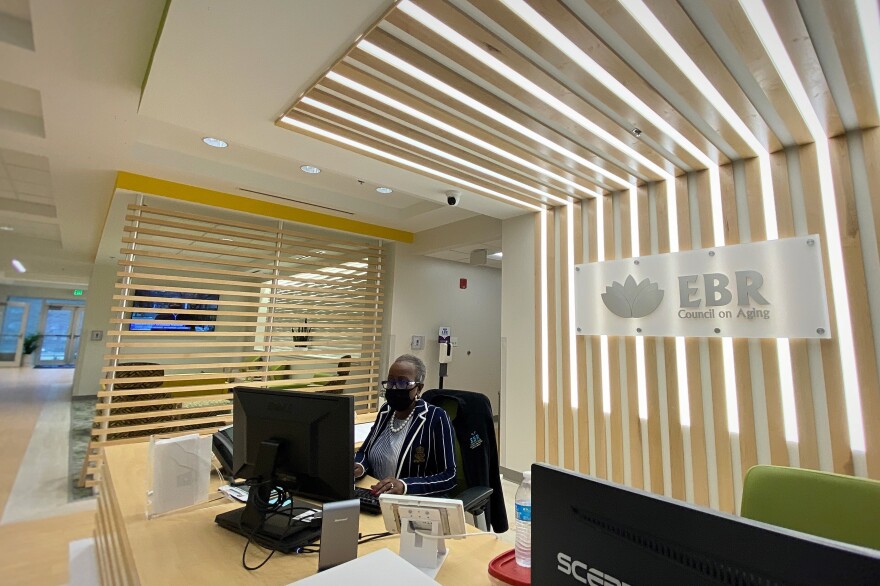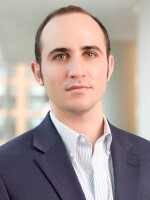Georgia Washington, 79, can't drive. Whenever she needs to go somewhere, she asks her daughter or her friends to pick her up.
She has lived in the northern part of Baton Rouge, a predominantly Black area of Louisiana's capital, since 1973. There aren't many resources there, including medical facilities. So when Washington fell ill with COVID-19 last March, she had to get a ride 20 minutes south to get medical attention.
Washington doesn't want to fall sick again, so she was eager to get vaccinated, which is in line with federal health recommendations. But she faced the same challenge she did last year: finding a local provider, this time for a vaccine. She tried for weeks, checking at pharmacies in the area. And she was put on a waiting list.
"I've got lots of patience," Washington said. "I just want to get it over with."
Communities of color have been disproportionately harmed by the COVID-19 pandemic. Now they're at risk of being left behind in the vaccine rollout.
Using data from several states that have published their own maps and lists of where vaccination sites are located, NPR identified disparities in the locations of vaccination sites in major cities across the Southern U.S. — with most sites placed in whiter neighborhoods.
NPR found this disparity by looking at Census Bureau statistics of non-Hispanic white residents and mapping where the vaccine sites were. NPR identified counties where vaccine sites tended to be in census tracts — roughly equivalent to neighborhoods — that had a higher percentage of white residents, compared with the census-tract average in that county. Reporters attempted to confirm the findings with health officials in nine counties across six states where the differences were most dramatic: Travis and Bastrop counties, Texas; East Baton Rouge Parish, La.; Hinds County, Miss.; Mobile County, Ala.; Chatham County, Ga.; DeKalb County, Ga.; Fulton County, Ga.; and Richland County, South Carolina.
The reasons are both unique to each place and common across the region: The health care locations that are logical places to distribute a vaccine tend to be located in the more affluent and whiter parts of town where medical infrastructure already exists. That presents a challenge for public health officials who are relying on what's already in place to mount a quick vaccination campaign.
It's a problem that exists not just in the South but across the country. A team of researchers at the West Health Policy Center and the University of Pittsburgh found nearly two dozen urban counties where Black residents would need to travel farther than white residents to a potential vaccination site — unless health officials act to narrow the disparities.
"We're hopeful there will be new facilities that are stood up," says Dr. Utibe Essien, an assistant professor of medicine at the University of Pittsburgh who studies health disparities and worked on the research team. "But what we saw play out with COVID testing was there were new facilities that came up, but they relied on existing infrastructure."
"This is structural and foundational to the racial disparities in our country."
Troubles getting vaccinated in Black neighborhoods
In the part of Baton Rouge where Georgia Washington lives, there is just one Walgreens where COVID-19 vaccines can be found.
Ever since an interstate was built through Baton Rouge in the 1960s, the population in the northern part of the city has struggled with housing, food insecurity, poverty and crime. These inequities have always fueled disparities in health care in Baton Rouge. The vaccine rollout is just the latest example.
"When you go to north Baton Rouge, there are very few [health care] choices. And then how many of those are participating in the vaccine program?" said Tasha Clark-Amar, CEO of the East Baton Rouge Council on Aging.
Loading...
Clark-Amar runs about two dozen senior centers around the city, and her organization stepped up to fill the pharmacy gap by obtaining and providing vaccines. Clark-Amar's group organized a pop-up clinic in mid-January, giving out around 1,000 doses that it secured from the grocery chain Albertsons. But another time, a community health clinic planned to give Clark-Amar around 150 doses for seniors — except the clinic couldn't deliver on that promise and she had to cancel the pop-up event at the last minute.

"I was livid. I was so angry and frustrated," she said. "Thirty-five of the people we had registered are between the ages of 80 and 99. Now you tell me, how am I supposed to pick?"
Clark-Amar has been able to schedule other pop-up events. In fact, that's how Washington was finally able to get a vaccine. She went to one of the council's pop-up events at a local community center in late January.
Clark-Amar says this patchwork of resources is part of life in many underresourced Black communities.
In the next state over, people are facing similar challenges. In Hinds County, Miss., where the state capital of Jackson sits, there's only one major drive-through site, which is where the state is sending the vast majority of doses. The state added the site in late January, weeks after it had already put two drive-throughs in the wealthier, whiter suburbs just outside the city.
"It took us a little bit of time to get it logistically set up to make sure we had a Hinds County site," Mississippi's state epidemiologist, Dr. Paul Byers, acknowledged at a recent news conference. "But we were always planning to do that. And we are glad that we have that now."
There's still a problem for the residents of Hinds County, nearly three-quarters of whom are Black: The vaccination site is north of downtown Jackson in a neighborhood that is 89% white and already has more medical facilities. It's close to a 30-minute drive from the more rural parts of the county, where many Black residents live.
In Alabama, the state has consistently ranked near the bottom in vaccine distribution since the rollout began.
But in terms of where the vaccine is available, NPR's analysis found a disparity in one of the state's largest counties. In Mobile County, 18 vaccination sites are listed on the Alabama Department of Public Health webpage. Fourteen are located in the whiter half of neighborhoods in the county.
Loading...
Rendi Murphree, director of the Bureau of Disease Surveillance and Environmental Services at the Mobile County Health Department, said it has been hard for the county to get any vaccines at all. She also said distribution is based on which sites have the capacity to store vaccines at very low temperatures.
Joe Womack, a native of a historically Black neighborhood known locally as Africatown, said Black communities in the northern part of Mobile have always dealt with poverty, pollution and health disparities.
"It's been a struggle ever since the '70s," said Womack, president of the Africatown community group C.H.E.S.S.
Beyond the South
Because of the need for a quick rollout, vaccination sites are largely dependent on the health care infrastructure already in place. Places such as pharmacies, clinics and hospitals make convenient sites for vaccines to be administered.
But the locations of those facilities can be inconvenient for millions of Americans. Those are the findings from a team of researchers at the nonpartisan West Health Policy Center and the University of Pittsburgh who analyzed the distance that Americans live from these types of places.
In 23 of the nation's urban counties, the researchers found, Black residents were less likely than white residents to be within a mile of a site that could potentially distribute vaccines. In just these counties, they estimated 2.4 million Black residents were farther than a mile.
Loading...
"We worry this is going to exacerbate disparities in outcomes even more now," says Inmaculada Hernandez, an assistant professor of pharmacy and therapeutics at the University of Pittsburgh who analyzed the data. "The limitations of existing infrastructure in counties are very different."
And it's not just in urban areas. In more than 250 other U.S. counties, the researchers found, Black residents were less likely than white residents to live within 10 miles driving distance of a site. Hernandez estimates the true number of places with this disparity to be higher, since the researchers only estimated based on a sample of county residents. Georgia and Virginia top the list of states with the most counties that have this disparity.
The Georgia Department of Public Health declined to comment on the University of Pittsburgh study. The Virginia Department of Health pointed to plans to deploy the National Guard to assist with vaccinations, as well as mass vaccination sites it set up at places like a convention center, a raceway complex and a vacated department store.
"A long history of racism"
The effects of this gap, coupled with historical trust issues between Black Americans and health care providers, are already reflected in the nationwide data showing who's getting vaccinated. According to a Centers for Disease Control and Prevention analysis published this week — which included race data on half of those who were vaccinated in the first month of the vaccination campaign — Blacks are lagging behind in vaccination rates, even when accounting for the demographics of health care workers and others who were in top priority groups.
Thomas LaVeist, a dean and health care equity researcher at Tulane University in New Orleans, says medical deserts go back into the early evolution of health care.
"But I do think that the South is perhaps more of a problem than some other parts of the country," says LaVeist, who is also co-chair of the Louisiana COVID-19 Health Equity Task Force. "Part of that is a long history of racism, Jim Crow and, in some cases, intentional actions that were taken to ensure that some communities did not have access to health care and other resources, while others did."
And it's not just Black neighborhoods having trouble getting access. In Texas, with its large population of recent immigrants, the problem of location and convenience is interwoven with a lack of trust.

Texas health officials recently designated several vaccination "hubs" around the state after advocates and local officials raised concerns about the state's initial plan to rely heavily on chain grocery stores and pharmacies to distribute the vaccine. The hubs will make their own decisions about where to distribute the vaccines they are allocated.
But as the Texas Tribune reported, when Dallas County tried to take it a step further by prioritizing ZIP codes where mostly Blacks and Hispanics live, state officials threatened to withhold doses.
The way that hubs allocate their vaccines is an especially important issue in smaller counties like Bastrop County, east of Austin.
The state's list of providers in the county shows they are almost all clustered around State Highway 71 — mostly in the city of Bastrop — which is far from the rural county's outskirts, where many Latinos live.
Loading...
Edie Clark, a leader with a local faith-based nonprofit, said her group is worried for neighborhoods like Stony Point, which is a small immigrant community in the county.
Clark said members of the Stony Point community are still reeling from events a few years ago when the Sheriff's Department turned over roughly a dozen residents to Immigration and Customs Enforcement for deportation. Many of those arrested were pulled over for minor traffic violations, like a broken taillight.
"They have a lot of distrust and fear of giving their information out without knowing it's not going to be used against them," she said.
Clark said it's tough to imagine that a lot of people in Stony Point will drive to get vaccinated in the city of Bastrop when they won't even drive there to get groceries. The U.S. Department of Homeland Security announced this week that immigration agencies will not make immigration enforcement arrests at vaccination sites.

Fast or fair
Reaching long-neglected communities takes time — and in the race to get vaccines to as many people as possible, time is in short supply.
Still, when the CDC outlined four ethical principles for the allocation of vaccines, two of them included equitable and fair distribution. CDC spokesperson Kristen Nordlund said, "Vaccine allocation strategies should aim to both reduce existing disparities and to not create new disparities."
But the pressure to get the vaccine out quickly means not everyone follows those principles. In South Carolina, the board of the state's Department of Health and Environmental Control shunned a proposal last week that would have factored age and "social vulnerability" metrics into its vaccine allocations. It opted instead to distribute solely by county population, citing a need for speed.
"I think when you look at speed, certainly, it's probably a lot easier and faster and quicker to do those calculations when it's just based on per capita," said Nick Davidson, the South Carolina health department's senior deputy for public health.
In Georgia, the high demand for COVID-19 vaccinations has left little opportunity for providers to build up new infrastructure to supplement what already exists or to work with members of historically marginalized communities on any hesitations they might have about getting vaccinated.
That's why the Good Samaritan Health Center in Atlanta has been saving a handful of its vaccination appointments for people who might want to meet with a health care provider at the clinic to ask questions before rolling up their sleeves.
"And at the end of most of those conversations, the person says, 'You know what? That was what I really needed. And now I'm ready to be vaccinated,' " said Breanna Lathrop, the clinic's chief operating officer.
Even for those eager to get the vaccine, it's hard to find in certain parts of the city. Only one of Atlanta's five large-scale county vaccination sites falls in the Black neighborhoods south of Interstate 20 — and that outlier sits in a shopping mall directly adjacent to the interstate on the outskirts of the city. Many of the smaller vaccination sites that are in those Black neighborhoods are grocery store pharmacies, which receive a much lower number of doses than what can be found at hospitals and the county sites.
Loading...
A few hours away in Savannah, Ga., NPR's analysis shows just one of Chatham County's half-dozen vaccination sites is located in a majority-Black neighborhood. That didn't surprise Nichele Hoskins. She's assistant director of a local YMCA-led coalition called Healthy Savannah and works to flatten out health disparities among people of color.
"In order to get people vaccinated, you're going to have to have that kind of trust," Hoskins said, noting it can seem a tedious process. "If you've ever done retail, it's going to take a little bit of hand-selling."

The Coastal Health District in Savannah, of course, can't take each patient by the hand. The health director, Dr. Lawton Davis, says it's tough to formalize a plan targeting Black residents, who make up about 42% of Chatham County's population. So far, the Coastal Health District has reached out to two Black churches and a community health center in a predominantly Black neighborhood to arrange mobile vaccination clinics. It's also using an existing hurricane evacuation registry of people with disabilities and health issues to help identify neglected neighborhoods around Savannah.
"There simply is not enough vaccine to go around," Davis says. "I don't have a formal document that says this is, you know, step A, B, C and D, but we have had reasonably in-depth discussions and we have, shall we say, a game plan on how we think this will go."
There are other options in a public health game plan.
"Alternative facilities come to mind," Jeni Hebert-Beirne, who leads the Collaboratory for Health Justice at the University of Illinois at Chicago's School of Public Health, wrote in an email to NPR. "Public libraries (an important source of free wifi), community centers/park districts, faith-based organizations, barber/beauty shops. These are places that people regularly convene/gather and places where people are more likely to feel they belong."
Shivani Patel, a researcher tracking COVID-19 health equity issues at Emory University in Atlanta, is quick to acknowledge that the problem is too large for a state's public health system to solve on its own. Like many across the country, Georgia's public health system has seen funding cuts in recent years that have reduced its capacity to respond to the pandemic.
Washington is also promising new support for states: A million more doses weekly are on their way to pharmacies, and the White House's COVID-19 czar said, "[Pharmacy] sites are selected based on their ability to reach some of the populations most at risk." The new sites are expected to start receiving the doses next week.
"Every day is potentially more lives lost," Patel said. "This is extremely urgent."
WWNO's Shalina Chatlani is a health care reporter for NPR's Gulf States Newsroom; she reported from Baton Rouge, Louisiana. KUT reporter Ashley Lopez reported from Bastrop, Texas. WABE reporter Sam Whitehead reported from Atlanta.
Methodology: NPR gathered addresses of permanent vaccination sites from state websites. NPR verified these sites by contacting county and state health officials in the nine counties mentioned in this report. Officials were offered the opportunity to review the findings and point to additional testing sites. What counts as a vaccination site varies by state. NPR geocoded vaccination site locations using the Google Geocoding API joined with Census Bureau shapefiles to determine what census tracts they were within. For each county, the analysis included only census tracts within the county's official boundaries. The Census Bureau provided demographic data per census tract. The main demographic measure referenced in this story was the percentage of the population that identifies as "white alone," not Hispanic or Latino. For percent white, NPR calculated the number of sites for tracts above and below the median county's percentage of white residents. Medians referenced are medians of census tracts and are not population totals, and may therefore differ slightly from population totals.
Copyright 2023 NPR. To see more, visit https://www.npr.org.






